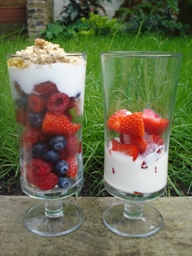By David Blyweiss, M.D., Advanced Natural Wellness
June 25, 2018
- Why is the energy density of food so important?
- Eat more and weigh less
- Tricky ways to reduce food density
Choosing foods that can help you cut calories and lose weight can be pretty confusing. But you may be able to cut through all of the confusion by zeroing in on one single factor: The energy density of the foods you are eating.
Now this is a term you don’t hear a lot about. But the concept is extremely easy to grasp.
On one hand you have low energy density foods. Fruits, vegetables, beans, soups, stews, lean meats and foods with a high fiber content are all considered low density. They provide a lot of nutrients, very few calories and often have a high water content.
On the other hand are your high energy density foods. Some examples of high energy density foods are fatty meats, fried foods, dairy products, desserts, processed foods and those that are high in sugar. Just small amounts of them can contain a high number of calories. At the same time, they typically have low nutritional values.
MD Exposes the Hidden Danger to Your Eyes

When your eyesight starts to fail, it's a real problem. Suddenly you can't go to the grocery store... you can't get to the doctor if you have an emergency... you can't meet your friends for dinner…
Your "regular" doctor doesn't have time to keep up with the latest research. And the same goes for eye doctors. They go to school to learn how to fit you for glasses and contacts, but have no way of preventing the damage and loss of eyesight that threatens your freedom and independence.
Let me show you something that explains a LOT about how your eyes work.
In my FREE Special Report, I'll show you a HUGE, untapped resource for your eyes that safely and naturally restores clear, effortless eyesight.
Click here to get started...
What does this mean for you?
Eat More and Weigh Less
When compared to high density foods, those that are low density provide fewer calories per gram of food when you eat them. This means you can eat larger portion sizes, while potentially slashing your caloric intake at the same time.
For example, take a look at the image on the right. The full-sized dessert consists of mixed berries, low fat plain yogurt and a sprinkling of granola. The weight of these three ingredients adds up to 300 grams.

Are You Suffering From...
- Love handles and a pot belly
- Romance that isn't what it used to
- Forgetfulness and inattention
- Low (or no) strength and endurance
- A sex drive that's shifted into neutral...or worse
If so...you may have Mature Male Burnout. Click here to discover more about this unique condition and what you can do about it.
The meager-sized serving contains only berries and cream. And not surprisingly it weighs much less, only 140 grams.
But guess what? They both have the same calorie count!
I don’t know about you, but I’d feel pretty cheated eating the small portion on the right. I’d probably have to go back for a second serving… which would certainly affect my caloric intake.
(This is exactly the type of problem we run into when we eat too many high energy density foods. The large number of calories contained in small-looking serving sizes is very deceptive!)
And here’s the real eye opener. Low density meals can fill you up just as well as ones with high density foods. This means you can eat large, satisfying portions of low energy foods that will keep you sated throughout the day… without worrying about calories.
Just as importantly, people who eat low energy density meals have improved appetite control and consume around 1,000 fewer calories each day. At the same time, there is a significant association between eating low energy density foods and reductions in body weight.
Tricky Ways to Reduce Food Density
If you’re concerned that low energy density foods won’t satisfy your cravings, don’t worry. There is any number of ways to reduce the energy density of your meals. Here are a few tricks to get you started.
- Add extra vegetables to your soups, stews and meals.
- Choose grilled or roasted meats and vegetables over those that are fried.
- Include more beans, peas and lentils in your meals. Serve them as a side or add them to your soups, chilies, stews and salads.
- Go easy on the sauces. If you load your foods up with buttery and creamy sauces, you’ll end up making them more energy dense.
- When it comes to creamy deserts, opt for making them with plain Greek yogurt over other dairy products.
Fill the greater portion of your plate with low density foods. Then fill in the remainder with small portions of energy dense foods, particularly those that are loaded with healthy fats. (Little known fact: healthy dietary fats can actually help you lose weight).
This includes foods like extra virgin olive oil, fatty fish, avocado, nuts and seeds that all have an important place in you diet. So don’t forget to include them as a healthy part of your daily meals. It’s also okay to enjoy reasonable portions of lean grassfed meat and pasture-raised poultry.
SOURCES:
Buckland NJ, et al. A Low Energy–Dense Diet in the Context of a Weight-Management Program Affects Appetite Control in Overweight and Obese Women. The Journal of Nutrition, Volume 148, Issue 5, 1 May 2018, Pages 798–806,
Stelmach-Mardas M, et al. Link between Food Energy Density and Body Weight Changes in Obese Adults. Nutrients. 2016 Apr; 8(4): 229.
Stelmach-Mardas M, et al. Link between Food Energy Density and Body Weight Changes in Obese Adults. Nutrients. 2016 Apr; 8(4): 229.







